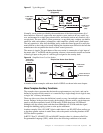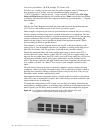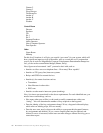
62 Handbook of Intercom Systems Engineering
unless otherwise noted, the comments also apply to ADAM™-CS and Zeus™ intercom
systems.
Previously, we discussed the analogy between telephone systems and matrix intercom
systems – the analogy is not correct in all cases, here are some exceptions.
Figure 5.1
Typical ADAM™ Matrix Connections
In ADAM™ matrix intercom systems, the connection between the matrix and keypanel is
normally via three twisted pairs of unshielded cable. As shown in Figure 5.1, one pair
carries balanced audio from the keypanel to the matrix, one pair does audio in the opposite
direction, and one pair is a RS-485 data signal which is shared among 8 panels in a group.
IMPORTANT
As eight panels share one physical data line, the matrix must have some means of
identifying which panel is sending data to it, and also have some means of addressing
messages to one specific panel of the eight. The key word in the previous sentence is
“addressing.” Each keypanel in the system must be assigned an address by one means or
another. On some keypanels this involves setting “dip switches” to select a “one of eight
address” via binary code (KP-9x family of panels). On other keypanels, the address is set
via rotary switch on the keypanel (KP-32 and Low Cost Series of Panels). And, on others
the means is via menus and firmware (KP-12 series of panels). In all cases, the factory set
default address has one chance in eight of being set correctly “out of the box.”
If a separate keypanel is attached to each of the 8 ports which share a data line, each panel
must have a unique address set which matches the physical port to which the panel is
connected. Having a panel with an address different from the physical port to which it is
connected will render that panel unusable (in a practical sense, even though the panel may
receive audio). Having two or more panels in a given group of 8 with the same address
will disrupt all eight panels in that group by causing data collisions on the common data
line. This is so important that I will repeat it. Having two or more panels in a given group
of eight with the same address will disrupt all eight panels in that group by causing data
collisions on the common data line.
At time of initial installation, or system modification, the great majority of anomalies can
be traced to improper addressing.





















